一、<s:action>標(biāo)簽
Action標(biāo)簽,顧名思義,是用來調(diào)用Action的標(biāo)簽,在JSP中頁面中,可以指向具體指定某一命名空間中的某一Action。而標(biāo)簽的主體用于顯示及渲染Actionr的處理結(jié)果。
1.WebRoot\pages\dataTagssuccess.jsp處理頁面
 <%@ page contentType="text/html; charset=GBK" %>
<%@ page contentType="text/html; charset=GBK" %>
 <%@ taglib prefix="s" uri="/struts-tags" %>
<%@ taglib prefix="s" uri="/struts-tags" %>
 <html>
<html>
 <head>
<head>
 <title>Action Tag 示例</title>
<title>Action Tag 示例</title>
 </head>
</head>
 <body>
<body>
 <h2>Action Tag 示例</h2>
<h2>Action Tag 示例</h2>
 <s:action name="success">
<s:action name="success">
 <b><i>s:action標(biāo)簽用于在頁面顯示結(jié)果.</i></b></div>
<b><i>s:action標(biāo)簽用于在頁面顯示結(jié)果.</i></b></div>
 </s:action>
</s:action>
 </body>
</body>
 </html>
</html>
這里使用<s:action>標(biāo)簽進(jìn)行頁面跳轉(zhuǎn),并用于顯示處理的結(jié)果。
2.先來看struts.xml中的配置:
 <action name="actionTag" class="com.sterning.actionTag">
<action name="actionTag" class="com.sterning.actionTag">
 <result name="success">/pages/dataTags/success.jsp</result>
<result name="success">/pages/dataTags/success.jsp</result>
 </action>
</action>
3.接著創(chuàng)建actionTag類:代碼如下:
 package com.sterning;
package com.sterning;
 import com.opensymphony.xwork2.ActionSupport;
import com.opensymphony.xwork2.ActionSupport;
 publicclass actionTag extends ActionSupport {
publicclass actionTag extends ActionSupport {
 public String execute() throws Exception{
public String execute() throws Exception{
 returnSUCCESS;
returnSUCCESS;
 }
}
 }
}
其實(shí)該類中沒有做任何處理,只是進(jìn)行頁面跳轉(zhuǎn)而已。
4.運(yùn)行效果。
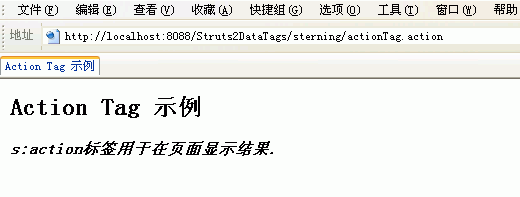
圖1.<s:action>標(biāo)簽
二、<s:bean>標(biāo)簽
Bean標(biāo)簽,當(dāng)然需要一個(gè)JavaBean。其的屬性值的操作是經(jīng)由Bean標(biāo)簽中的參數(shù)屬性來進(jìn)行賦值。當(dāng)然,它還有一個(gè)id屬性可以進(jìn)行賦值,由于就可以在上下文中使用這個(gè)Bean。請看如下的頁面:
1.WebRoot\pages\dataTags\beanTag.jsp,代碼如下:
 <%@ page contentType="text/html; charset=GBK" %>
<%@ page contentType="text/html; charset=GBK" %>
 <%@ taglib prefix="s" uri="/struts-tags" %>
<%@ taglib prefix="s" uri="/struts-tags" %>
 <html>
<html>
 <head>
<head>
 <title>Bean Tag 示例</title>
<title>Bean Tag 示例</title>
 </head>
</head>
 <body>
<body>
 <h2>Bean Tag 示例</h2>
<h2>Bean Tag 示例</h2>
 <s:bean name="com.sterning.companyName" id="uid">
<s:bean name="com.sterning.companyName" id="uid">
 <s:param name="name">sterning</s:param>
<s:param name="name">sterning</s:param> 
 <s:property value="%{name}" /><br>
<s:property value="%{name}" /><br>
 </s:bean>
</s:bean>
 </body>
</body>
 </html>
</html>
可參其關(guān)聯(lián)的JavaBean是com.sterning.companyName,同時(shí)參數(shù)name賦值為sterning。
2.首先創(chuàng)建Action進(jìn)行跳轉(zhuǎn), src\com\sterning\beanTag.java,代碼如下:
 package com.sterning;
package com.sterning;
 import com.opensymphony.xwork2.ActionSupport;
import com.opensymphony.xwork2.ActionSupport;
 public class beanTag extends ActionSupport {
public class beanTag extends ActionSupport {
 public String execute() throws Exception{
public String execute() throws Exception{
 return SUCCESS;
return SUCCESS;
 }
}
 }
}
然后創(chuàng)建JavaBean,src\com\sterning\companyName.java,代碼如下:
 package com.sterning;
package com.sterning;
 public class companyName {
public class companyName {
 private String name;
private String name;
 public void setName(String name){
public void setName(String name){
 this.name =name ;
this.name =name ;
 }
}
 public String getName(){
public String getName(){
 return name;
return name;
 }
}
 }
}
3.Struts.xml的配置
這里配置很簡單,與前面的例子差不多。
 <action name="beanTag" class="com.sterning.beanTag">
<action name="beanTag" class="com.sterning.beanTag">
 <result name="success">/pages/dataTags/beanTag.jsp</result>
<result name="success">/pages/dataTags/beanTag.jsp</result>
 </action>
</action>
4.運(yùn)行效果

圖2.<s:bean>標(biāo)簽
三、<s:date>標(biāo)簽
Data標(biāo)簽方便在頁面進(jìn)行格式化的日期輸出。格式有多種可供選擇。同時(shí),還可以通過在properties屬性文件中定義好”struts.date.format”參數(shù)的值,從而自定義格式輸出。
Date標(biāo)簽包含三個(gè)屬性,可以從下面的代碼中感受一下,分別是:
l Name:
l Nice
l Format
1.WebRoot\pages\dataTags\dateTag.jsp
 <%@ page contentType="text/html; charset=GBK" %>
<%@ page contentType="text/html; charset=GBK" %>
 <%@ taglib prefix="s" uri="/struts-tags" %>
<%@ taglib prefix="s" uri="/struts-tags" %>
 <html>
<html>
 <head>
<head>
 <title>Date Tag 示例</title>
<title>Date Tag 示例</title>
 </head>
</head>
 <body>
<body>
 <h2>顯示當(dāng)前的時(shí)間</h2>
<h2>顯示當(dāng)前的時(shí)間</h2>
 <table border="1" width="35%">
<table border="1" width="35%">
 <tr>
<tr>
 <td><b>日期格式</b></td>
<td><b>日期格式</b></td>
 <td><b>日期</b></td>
<td><b>日期</b></td>
 </tr>
</tr>
 <tr>
<tr>
 <td>Day/Month/Year</td>
<td>Day/Month/Year</td>
 <td><s:date name="currentDate" format="dd/MM/yyyy" /></td>
<td><s:date name="currentDate" format="dd/MM/yyyy" /></td>
 </tr>
</tr>
 <tr>
<tr>
 <td>Month/Day/Year</td>
<td>Month/Day/Year</td>
 <td><s:date name="currentDate" format="MM/dd/yyyy" /></td>
<td><s:date name="currentDate" format="MM/dd/yyyy" /></td>
 </tr>
</tr>
 <tr>
<tr>
 <td>Month/Day/Year</td>
<td>Month/Day/Year</td>
 <td><s:date name="currentDate" format="MM/dd/yy" /></td>
<td><s:date name="currentDate" format="MM/dd/yy" /></td>
 </tr>
</tr>
 <tr>
<tr>
 <td>Month/Day/Year Hour<B>:</B>Minute</td>
<td>Month/Day/Year Hour<B>:</B>Minute</td>
 <td><s:date name="currentDate" format="MM/dd/yy hh:mm" /></td>
<td><s:date name="currentDate" format="MM/dd/yy hh:mm" /></td>
 </tr>
</tr>
 <tr>
<tr>
 <td>Month/Day/Year Hour<B>:</B>Minute<B>:</B>Second</td>
<td>Month/Day/Year Hour<B>:</B>Minute<B>:</B>Second</td>
 <td><s:date name="currentDate" format="MM/dd/yy hh:mm:ss" /></td>
<td><s:date name="currentDate" format="MM/dd/yy hh:mm:ss" /></td>
 </tr>
</tr>
 <tr>
<tr>
 <td>Nice Date (Current Date & Time)</td>
<td>Nice Date (Current Date & Time)</td>
 <td><s:date name="currentDate" nice="false" /></td>
<td><s:date name="currentDate" nice="false" /></td>
 </tr>
</tr>
 <tr>
<tr>
 <td>Nice Date</td>
<td>Nice Date</td>
 <td><s:date name="currentDate" nice="true" /></td>
<td><s:date name="currentDate" nice="true" /></td>
 </tr>
</tr>
 </table>
</table>
 </body>
</body>
 </html>
</html>
2.src\com\sterning\beanTag.java
該項(xiàng)類更加簡單,頁面跳轉(zhuǎn)
 package com.sterning;
package com.sterning;
 import com.opensymphony.xwork2.ActionSupport;
import com.opensymphony.xwork2.ActionSupport;
 public class beanTag extends ActionSupport {
public class beanTag extends ActionSupport {
 public String execute() throws Exception{
public String execute() throws Exception{
 return SUCCESS;
return SUCCESS;
 }
}
 }
}
3.Struts.xml配置
 <action name="dateTag" class="com.sterning.dateTag">
<action name="dateTag" class="com.sterning.dateTag">
 <result>/pages/dataTags/dateTag.jsp</result>
<result>/pages/dataTags/dateTag.jsp</result>
 </action>
</action>
4.運(yùn)行效果
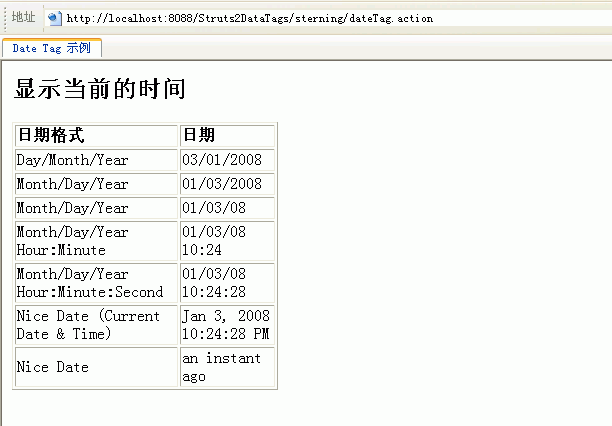
圖3.<s:date>標(biāo)簽
四、<s:include>標(biāo)簽
<s:include>標(biāo)簽用于在當(dāng)前頁面中包含來自其它servlet或JSP頁面的處理結(jié)果。由于是頁面與頁面(或servlet)之間的頁面包含,因此不需要action來進(jìn)行頁面的跳轉(zhuǎn)。
1.WebRoot\pages\dataTags\includeTag.jsp
 <%@ page contentType="text/html; charset=GBK" %>
<%@ page contentType="text/html; charset=GBK" %>
 <%@ taglib prefix="s" uri="/struts-tags" %>
<%@ taglib prefix="s" uri="/struts-tags" %>
 <html>
<html>
 <head>
<head>
 <title>Include Tag 示例</title>
<title>Include Tag 示例</title>
 </head>
</head>
 <body>
<body>
 <h2>Include Tag 示例</h2>
<h2>Include Tag 示例</h2>
 <s:include value="myBirthday.jsp" />
<s:include value="myBirthday.jsp" />
 </body>
</body>
 </html>
</html>
這里包含了另外一個(gè)頁面myBirthday.jsp,其實(shí)相當(dāng)于在JSP頁面里包含其它的頁面。原理一樣的。
2.WebRoot\pages\dataTags\myBirthday.jsp
這個(gè)頁面利用了上面所講的<s:date>標(biāo)簽進(jìn)行日期的格式化輸出
 <%@ page contentType="text/html; charset=GBK" %>
<%@ page contentType="text/html; charset=GBK" %>
 <%@ taglib prefix="s" uri="/struts-tags" %>
<%@ taglib prefix="s" uri="/struts-tags" %>
 <html>
<html>
 <head>
<head>
 <title>Include Tag 示例</title>
<title>Include Tag 示例</title>
 </head>
</head>
 <body>
<body>
 <table border="1" width="35%">
<table border="1" width="35%">
 <tr>
<tr>
 <td><b>Date Format</b></td>
<td><b>Date Format</b></td>
 <td><b>Date</b></td>
<td><b>Date</b></td>
 </tr>
</tr>
 <tr>
<tr>
 <td>Day/Month/Year</td>
<td>Day/Month/Year</td>
 <td><s:date name="myBirthday" format="dd/MM/yyyy" /></td>
<td><s:date name="myBirthday" format="dd/MM/yyyy" /></td>
 </tr>
</tr>
 <tr>
<tr>
 <td>Month/Day/Year</td>
<td>Month/Day/Year</td>
 <td><s:date name="myBirthday" format="MM/dd/yyyy" /></td>
<td><s:date name="myBirthday" format="MM/dd/yyyy" /></td>
 </tr>
</tr>
 <tr>
<tr>
 <td>Month/Day/Year</td>
<td>Month/Day/Year</td>
 <td><s:date name="myBirthday" format="MM/dd/yy" /></td>
<td><s:date name="myBirthday" format="MM/dd/yy" /></td>
 </tr>
</tr>
 <tr>
<tr>
 <td>Month/Day/Year Hour<B>:</B>Minute</td>
<td>Month/Day/Year Hour<B>:</B>Minute</td>
 <td><s:date name="myBirthday" format="MM/dd/yy hh:mm" /></td>
<td><s:date name="myBirthday" format="MM/dd/yy hh:mm" /></td>
 </tr>
</tr>
 <tr>
<tr>
 <td>Month/Day/Year Hour<B>:</B>Minute<B>:</B>Second</td>
<td>Month/Day/Year Hour<B>:</B>Minute<B>:</B>Second</td>
 <td><s:date name="myBirthday" format="MM/dd/yy hh:mm:ss" /></td>
<td><s:date name="myBirthday" format="MM/dd/yy hh:mm:ss" /></td>
 </tr>
</tr>
 <tr>
<tr>
 <td>Nice Date (Current Date & Time)</td>
<td>Nice Date (Current Date & Time)</td>
 <td><s:date name="myBirthday" nice="false" /></td>
<td><s:date name="myBirthday" nice="false" /></td>
 </tr>
</tr>
 </table>
</table>
 </body>
</body>
 </html>
</html>
3.Struts.xml配置
 <action name="includeTag" class="com.sterning.includeTag">
<action name="includeTag" class="com.sterning.includeTag">
 <result>/pages/dataTags/includeTag.jsp</result>
<result>/pages/dataTags/includeTag.jsp</result>
 </action>
</action>
4.運(yùn)行效果
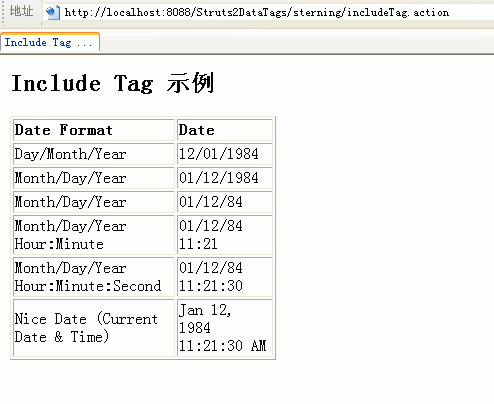
圖4.<s:include>標(biāo)簽
五、<s:param>標(biāo)簽
Param標(biāo)簽用于傳遞參數(shù),如給<s:bean>標(biāo)簽傳遞參數(shù)。它有如下兩個(gè)屬性:
l Name(String):參數(shù)名;
l Value(Object):參數(shù)值。
1.WebRoot\pages\dataTags\paramTag.jsp
 <%@ page contentType="text/html; charset=GBK" %>
<%@ page contentType="text/html; charset=GBK" %>
 <%@ taglib prefix="s" uri="/struts-tags" %>
<%@ taglib prefix="s" uri="/struts-tags" %>
 <html>
<html>
 <head>
<head>
 <title>Param Tag 示例</title>
<title>Param Tag 示例</title>
 </head>
</head>
 <body>
<body>
 <h2>Param Tag 示例</h2>
<h2>Param Tag 示例</h2>
 <ui:component>
<ui:component>
 <ui:param name="empname">Emp1</ui:param><br>
<ui:param name="empname">Emp1</ui:param><br>
 <ui:param name="empname">Emp2</ui:param><br>
<ui:param name="empname">Emp2</ui:param><br>
 <ui:param name="empname">Emp3</ui:param>
<ui:param name="empname">Emp3</ui:param> 
 </ui:component>
</ui:component>
 </body>
</body>
 </html>
</html>
2.Struts.xml配置
 <action name="paramTag">
<action name="paramTag">
 <result>/pages/dataTags/paramTag.jsp</result>
<result>/pages/dataTags/paramTag.jsp</result>
 </action>
</action>
3.運(yùn)行效果
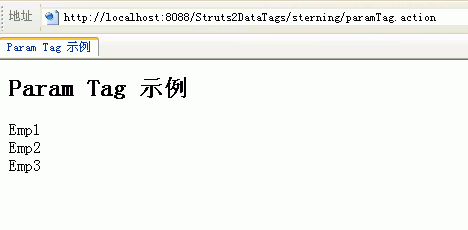
圖5.<s:param>標(biāo)簽
六、<s:set>標(biāo)簽
Set標(biāo)簽比較簡單。Set標(biāo)簽用戶將某一值賦給某一變量,因此,任何對該項(xiàng)值的引用都可以通過該變量來得到該值。該變量的活動(dòng)范圍可自定義。如下例中,定義一健/值對,對值的引用,直接引用值就可以。。請看示例
1.WebRoot\pages\dataTags\ setTag.jsp
 <%@ page contentType="text/html; charset=GBK" %>
<%@ page contentType="text/html; charset=GBK" %>
 <%@ taglib prefix="s" uri="/struts-tags" %>
<%@ taglib prefix="s" uri="/struts-tags" %>
 <html>
<html>
 <head>
<head>
 <title>Set Tag 示例</title>
<title>Set Tag 示例</title>
 </head>
</head>
 <body>
<body>
 <h2>Set Tag 示例</h2>
<h2>Set Tag 示例</h2>
 <s:set name="technologyName" value="%{'Java'}"/>
<s:set name="technologyName" value="%{'Java'}"/>
 Technology Name: <s:property value="#technologyName"/>
Technology Name: <s:property value="#technologyName"/>
 </body>
</body>
 </html>
</html>
2.Struts.xml配置
 <action name="setTag">
<action name="setTag">
 <result>/pages/dataTags/setTag.jsp</result>
<result>/pages/dataTags/setTag.jsp</result>
 </action>
</action>
3.運(yùn)行效果
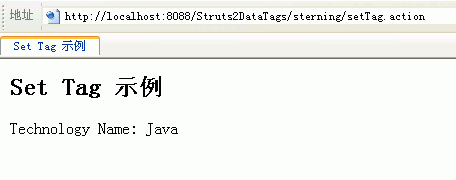
圖6.<s:set>標(biāo)簽
七、<s:property>標(biāo)簽
Property顧名思義,可以與<s:bean>標(biāo)簽結(jié)合使用,一個(gè)是給bean賦值,一個(gè)是從bean中讀取值。直接來看示例:
1.WebRoot\pages\dataTags\propertyTag.jsp
 <%@ page contentType="text/html; charset=GBK" %>
<%@ page contentType="text/html; charset=GBK" %>
 <%@ taglib prefix="s" uri="/struts-tags" %>
<%@ taglib prefix="s" uri="/struts-tags" %>
 <html>
<html>
 <head>
<head>
 <title>Property Tag 示例</title>
<title>Property Tag 示例</title>
 </head>
</head>
 <body>
<body>
 <h2>Property Tag 示例</h2>
<h2>Property Tag 示例</h2>
 <!-- Example to pick the value through bean class -->
<!-- Example to pick the value through bean class -->
 <s:bean name="com.sterning.companyName" id="uid">
<s:bean name="com.sterning.companyName" id="uid">
 <s:param name="name">sterning</s:param>
<s:param name="name">sterning</s:param> 
 <s:property value="%{name}" /><br>
<s:property value="%{name}" /><br>
 </s:bean>
</s:bean>
 <!-- Default value -->
<!-- Default value -->
 <s:property value="name" default="Default Value" />
<s:property value="name" default="Default Value" />
 </body>
</body>
 </html>
</html>
2.Bean
當(dāng)然這里用到了Bean. com\sterning\ companyName.java,代碼如下:
 package com.sterning;
package com.sterning;
 public class companyName {
public class companyName {
 private String name;
private String name;
 public void setName(String name){
public void setName(String name){
 this.name =name ;
this.name =name ;
 }
}
 public String getName(){
public String getName(){
 return name;
return name;
 }
}
 }
}
3.src"com"sterning" propertyTag.java
進(jìn)行頁面跳轉(zhuǎn)
 package com.sterning;
package com.sterning;
 import com.opensymphony.xwork2.ActionSupport;
import com.opensymphony.xwork2.ActionSupport;
 public class propertyTag extends ActionSupport {
public class propertyTag extends ActionSupport {
 public String execute() throws Exception{
public String execute() throws Exception{
 return SUCCESS;
return SUCCESS;
 }
}
 }
}
4.Struts.xml配置
 <action name="propertyTag" class="com.sterning.propertyTag">
<action name="propertyTag" class="com.sterning.propertyTag">
 <result>/pages/dataTags/propertyTag.jsp</result>
<result>/pages/dataTags/propertyTag.jsp</result>
 </action>
</action>
5.運(yùn)行效果
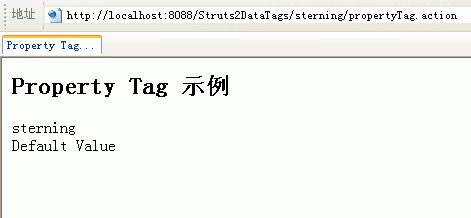
圖7.<s:property>標(biāo)簽






